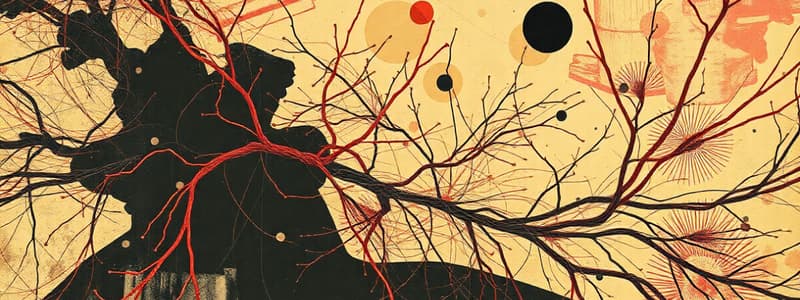Podcast
Questions and Answers
The plasma membrane of eukaryotic cells is supported by:
The plasma membrane of eukaryotic cells is supported by:
- lamins
- microtubules
- actin filaments (correct)
- intermediate filaments
Three major groups of filament systems comprising the cytoskeleton are all composed of polymers of assembled subunits, which vary in thickness when assembled. Which is the correct order, from smallest to largest, of the filament systems?
Three major groups of filament systems comprising the cytoskeleton are all composed of polymers of assembled subunits, which vary in thickness when assembled. Which is the correct order, from smallest to largest, of the filament systems?
- microtubules, microfilaments, intermediate filaments
- intermediate filaments, microtubules, microfilaments
- microfilaments, microtubules, intermediate filaments
- none of the above (correct)
Actin-binding proteins that generate actin filament bundles:
Actin-binding proteins that generate actin filament bundles:
- are long and flexible
- can also bundle microtubules
- are short and inflexible (correct)
- bind only to the ends of actin filaments
Decoration of actin filaments with myosin S1 is commonly used to:
Decoration of actin filaments with myosin S1 is commonly used to:
Many actin cross-linking proteins contain:
Many actin cross-linking proteins contain:
At ATP-G-actin concentrations that are intermediate between the Cc for the (+) end and the Cc for the (-) end, ____ will be observed. The Cc needed for elongation at the (+) end is ____ than that at the (-) end of actin microfilaments.
At ATP-G-actin concentrations that are intermediate between the Cc for the (+) end and the Cc for the (-) end, ____ will be observed. The Cc needed for elongation at the (+) end is ____ than that at the (-) end of actin microfilaments.
All of the following statements about actin assembly are correct EXCEPT:
All of the following statements about actin assembly are correct EXCEPT:
Gelsolin is activated by:
Gelsolin is activated by:
During treadmilling, actin subunits add:
During treadmilling, actin subunits add:
Which of the following proteins promotes actin assembly and is involved in signaling pathways controlling actin assembly at the plasma membrane?
Which of the following proteins promotes actin assembly and is involved in signaling pathways controlling actin assembly at the plasma membrane?
Listeria is a bacterial parasite that has evolved unique ways to enter animal cells and then use actin polymerization for its intracellular movement. Which of the following statements is true in regards to Listeria and actin polymerization?
Listeria is a bacterial parasite that has evolved unique ways to enter animal cells and then use actin polymerization for its intracellular movement. Which of the following statements is true in regards to Listeria and actin polymerization?
Which of the following is a G-actin sequestering protein that allows cells to maintain a relatively high G-actin concentration in cells?
Which of the following is a G-actin sequestering protein that allows cells to maintain a relatively high G-actin concentration in cells?
Cofilin:
Cofilin:
If the activity of thymosin β4 was inhibited in fibroblasts, the overall effect would be:
If the activity of thymosin β4 was inhibited in fibroblasts, the overall effect would be:
The two proteins that play the most important role in actin microfilament elongation are:
The two proteins that play the most important role in actin microfilament elongation are:
What would occur if CapZ was inhibited in cells?
What would occur if CapZ was inhibited in cells?
Which of the following proteins is involved in formation of actin bundles in microvilli by providing crosslinks between actin filaments?
Which of the following proteins is involved in formation of actin bundles in microvilli by providing crosslinks between actin filaments?
How do the different types of actin-binding proteins relate to the ability of actin to form bundles and networks?
How do the different types of actin-binding proteins relate to the ability of actin to form bundles and networks?
Which region of myosin interacts with actin filaments?
Which region of myosin interacts with actin filaments?
Which of the following properties is not shared by all myosins?
Which of the following properties is not shared by all myosins?
All myosins move toward the (+) end of actin filaments EXCEPT:
All myosins move toward the (+) end of actin filaments EXCEPT:
In the operational model for movement of myosin along an actin filament, the power stroke occurs during:
In the operational model for movement of myosin along an actin filament, the power stroke occurs during:
What is the function of CapZ and tropomodulin in the sarcomere?
What is the function of CapZ and tropomodulin in the sarcomere?
In the budding yeast S. cerevisiae, which of the following is NOT transported into the bud by myosin V?
In the budding yeast S. cerevisiae, which of the following is NOT transported into the bud by myosin V?
Multinucleated cells may result from a defect in:
Multinucleated cells may result from a defect in:
Which of the following is NOT a function of myosin-powered movements?
Which of the following is NOT a function of myosin-powered movements?
Membrane extension during cell locomotion is driven by:
Membrane extension during cell locomotion is driven by:
Lamellipodia are located:
Lamellipodia are located:
The elastic Brownian ratchet model has been proposed to explain:
The elastic Brownian ratchet model has been proposed to explain:
Small G proteins, including Rho, Rac, and Cdc42, contribute to the coordinated movement and overall polarity of a migrating cell. Assuming that the cell is migrating in a left-to-right fashion, which of the following is correct?
Small G proteins, including Rho, Rac, and Cdc42, contribute to the coordinated movement and overall polarity of a migrating cell. Assuming that the cell is migrating in a left-to-right fashion, which of the following is correct?
The correct order of events in cell locomotion is:
The correct order of events in cell locomotion is:
In response to a chemotactic signal, a cell forms structures to aid in locomotion. In lamellipodia, active Rac will stimulate F-actin polymerization at the leading edge via ____, whereas actin that will form stress fibers will be recruited by formin downstream of activation of this small GTPase ____
In response to a chemotactic signal, a cell forms structures to aid in locomotion. In lamellipodia, active Rac will stimulate F-actin polymerization at the leading edge via ____, whereas actin that will form stress fibers will be recruited by formin downstream of activation of this small GTPase ____
In a scratch wound assay, cells are treated with inhibitors of Rho kinase. What would be observed?
In a scratch wound assay, cells are treated with inhibitors of Rho kinase. What would be observed?
Within an actin filament, each actin subunit is surrounded by _____ neighboring actin subunits.
Within an actin filament, each actin subunit is surrounded by _____ neighboring actin subunits.
Flashcards
Microfilament support
Microfilament support
The plasma membrane of eukaryotic cells is supported by actin filaments.
Cytoskeleton filament order (smallest to largest)
Cytoskeleton filament order (smallest to largest)
microfilaments, microtubules, intermediate filaments
Actin filament bundling proteins
Actin filament bundling proteins
Short and inflexible proteins that create actin filament bundles.
Myosin S1 decoration
Myosin S1 decoration
Signup and view all the flashcards
Actin cross-linking proteins CH domain
Actin cross-linking proteins CH domain
Signup and view all the flashcards
Actin subunit neighbors
Actin subunit neighbors
Signup and view all the flashcards
Negative stain electron microscopy actin filament appearance
Negative stain electron microscopy actin filament appearance
Signup and view all the flashcards
Actin filament bundling/networking
Actin filament bundling/networking
Signup and view all the flashcards
Actin filament treadmilling
Actin filament treadmilling
Signup and view all the flashcards
Gelsolin activation
Gelsolin activation
Signup and view all the flashcards
Actin assembly in polymerization
Actin assembly in polymerization
Signup and view all the flashcards
Profilin's Role
Profilin's Role
Signup and view all the flashcards
Myosin interaction region
Myosin interaction region
Signup and view all the flashcards
Myosin property not shared
Myosin property not shared
Signup and view all the flashcards
Myosin Movement Direction
Myosin Movement Direction
Signup and view all the flashcards
Myosin power stroke
Myosin power stroke
Signup and view all the flashcards
CapZ and Tropomodulin roles
CapZ and Tropomodulin roles
Signup and view all the flashcards
Cell locomotion driven by
Cell locomotion driven by
Signup and view all the flashcards
Lamellipodia location
Lamellipodia location
Signup and view all the flashcards
Cell grip on substrate
Cell grip on substrate
Signup and view all the flashcards
Study Notes
Cell Organization and Movement I: Microfilaments
- Eukaryotic cell plasma membranes are supported by actin filaments.
- Cytoskeletal filament systems include microtubules, microfilaments, and intermediate filaments. The correct order from smallest to largest is: microfilaments, microtubules, intermediate filaments.
- Actin filament bundles are generated by actin-binding proteins. These proteins are short and inflexible.
- Myosin S1 decoration of actin filaments is used to attach actin filaments to cell membranes.
- Actin cross-linking proteins frequently contain a CH domain.
- Within an actin filament, each actin subunit is surrounded by four neighboring actin subunits.
- Actin filaments appear as twisted strings of beads with a diameter of 7-9 nm when viewed by negative stain electron microscopy.
- Actin filament networks and bundles are created by different actin-binding proteins (ABPs). Bundling proteins tend to be short and inflexible, whereas networking proteins tend to be longer and more flexible.
- ATP-G-actin concentrations intermediate between the Cc for the (+) end and the Cc for the (-) end of microfilaments result in treadmilling which is the observable growth and shrinking effect.
- Actin assembly is correct except that actin (-) ends do not assemble more quickly than actin (+) ends.
- Gelsolin activation occurs through Ca²⁺ binding.
- Treadmilling predominantly adds actin subunits to the (+) end of a filament.
- Actin assembly is promoted, and the signaling pathways for actin assembly at the plasma membrane are influenced by a protein.
- Listeria uses actin polymerization for intracellular movement. The Listeria ActA protein enhances ATP-actin assembly by binding to VASP.
- Gelsolin severs actin filaments and caps (+) ends of the resulting pieces and is activated by Ca²⁺ binding.
- Thymosin ẞ4 sequesters G-actin to maintain a high G-actin concentration in cells.
- Leukocytes engulf bacteria through a coordinated mechanism involving cell-surface receptors and the actin cytoskeleton. The antibodies recognize the bacterial surface proteins and bind, followed by a recruitment of actin networks at the site, resulting eventually in the bacteria becoming completely engulfed and degraded.
- G-actin sequestering proteins help maintain high G-actin concentrations in cells, and the key protein is thymosin ß4.
- The head domain of myosin binds to actin, tail domains bind to other molecules, and the neck domain regulates the activity of the head domain.
- The power stroke of myosin movement along an actin filament occurs during the release of phosphate (Pi).
- CapZ and tropomodulin center the myosin thick filaments and maintain a constant actin thin filament length in sarcomeres.
- Actin in erythrocytes is arranged in a fishnet structure and is linked to bicarbonate transporters and glycophorin C by ankyrin and band 4.1 protein, respectively.
- Actin plays a key role in cell movement and shape change.
- The head domain of myosin binds ATP, the neck domain coordinates the head domain's activity, and the tail domain binds cellular cargo.
- Actin interactions are key mechanisms for cell locomotion and cell shape change.
- Myosin binds actin and uses the energy from ATP hydrolysis to generate movement. Myosin tail domains bind cargo.
- Lamellipodia are located at the leading edge of a moving cell.
- Small G proteins (Rho, Rac, and Cdc42) coordinate cell movement and polarity.
Studying That Suits You
Use AI to generate personalized quizzes and flashcards to suit your learning preferences.
Related Documents
Description
Explore the intricate details of microfilaments and their role in eukaryotic cell organization. This quiz covers the structure and function of actin filaments, the proteins involved, and their significance in cytoskeletal systems. Test your knowledge on actin dynamics and its applications in cellular movement.




